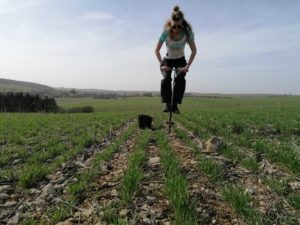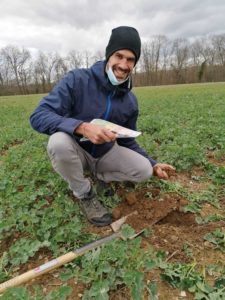SoilPioneers: Bastien Sachet, CEO Earthworm Foundation
Published on by Trudi Schifter, CEO and Founder AquaSPE in Case Studies
As part of our new #SoilPioneers series, AQUA4D is speaking with some of the people making tangible impacts across the world in the name of soil health and regenerative agriculture. This week we speak with Bastien Sachet, CEO of Earthworm Foundation who are furthering the cause of regenerative agriculture around the world.
Q: Bastien, firstly how would you define Regenerative Agriculture?
A: Well for me I define it by the opposite: it is not extractive but rather replenishes soil and biodiversity and the elements that allow plants to grow. We can add to this a social dimension: by replenishing nature, this also replenishes people. For me agriculture is a connection between people and nature. The farmer is the link between what the plants give you and what you then consume as a human. Reg Ag is an approach that after it happens it brings more to everyone than it did before.
Q: Part of Earthworm’s mission is ‘regenerating supply chains by restoring soils‘; what variables impact upon soil health?
A: We’ve tried to nail how to measure soil health in a way which is scientific but also practicable. Here we are looking at 3 things: physical fertility, chemical fertility, and biological fertility. We combine these to get to an indicator of soil health. Often factors such as pH and bioturbation are proxies of other things. Of course, this all moves very slowly, so we also work with elements such as crop cover and green cover (which we check by satellites) to look at what farmers are already doing positively.
Q: How do you see the interconnection between water and soil health?
A: One thing key to regenerative agriculture is water, because without water you don’t grow cover crops or anything else. We’ve seen a lot of examples in even places like Normandy where some of the cover crops don’t come up as they’re lacking water. You can’t restore soils if you don’t have enough water. Of course, practicing Reg Ag and having better soil health will retain more water and decrease the need for irrigation in future, but how do you make that transition? That can be a big hurdle for farmers.
One thing we’ve looked at is how impact finance can accelerate transitions. As we analyzed what farmers are taking loans for, we found that mostly they’re taking loans for irrigation. This means they’re trying to find a way to grow their crops, and ultimately this will help the cause of Reg Ag too.
I really think this is a key topic because rainwater has no minerals and is what plants grow with – if you go back towards a natural system of growing you have to go back as close as possible to rain water.
An Earthworm agronomist doing field analysis
Q: Earthworm has persuaded some big players to make transform their supply chains – how?
A: Companies are influenced by 3 things: NGOs, investors and their consumers. What we do is catalyze all this, bringing resources and practicable experience together. Over the years, big companies have become disconnected from their sourcing bases. We have shown them transparent supply chains are possible, and to then view not only the price and product quality but also the environmental and social quality. Additionally, we help companies understand the interconnectedness of problems across the world – we are a neutral agent, working with NGOs and scientists on the ground to address issues. It’s not about finding who’s guilty but rather showing that we are all responsible in some way.
I think big companies now generally grasp the “Why” more and more, and now we show them the “How” – how do we make change happen concretely? It’s the approach of a doctor – he’s kind and not here to judge you but realize how you got to this point, how you can restore health and get better. Most importantly, we build trust, which allows us to effectively work on solutions together. We’re not selling a solution, we’re bringing an approach.
Bastien Sachet out in the field.
Q: Is it a question of nature-based vs tech-based?
A: Our view is that technology should serve people. We value the fact that technology can serve purposes, such as satellite monitoring of cover crops or deforestation. We don’t necessarily push for technological solutions but our team are aware of what’s out there and what can be done with technology.
Q: What are the barriers to this sustainable transition?
A: In the end, it’s about people. When people really want to make it happen, they find a way but they all need to understand the “Why”, the “How” and the “What” – whether investor or farmer. When they’re aligned, great things can happen.
But for the last 30-40 years all we’ve done is go in completely the opposite direction, and there’s been tension in the supply chain which has generated profits at the expense of natural resources and capital. We need to regenerate these relationships AND the natural ecosystems. The basis is to recreate trust in each other and nature. Beyond the effective work which is being done
Impact finance has a big role to play, to inject cash for farmers to reinvest into good solutions and a more modern way of doing things, and provide non-biased technical and agronomical support.
Q: How far along the road are we to a truly regenerative agriculture?
A: We’re making progress, but I still think we’re around 2-3% along the world in practice, because it takes time to change. Everyone says “We want to go there” but the financing, technologies, know-how and implantation is still not widespread. I’m very hopeful that this is going to accelerate – in the next 10 years this is going to be THE way to do agriculture. It’s moving very fast and I believe things will change.
In some places the link between people and land has been broken, and the relationship with the land has been lost. Big investment companies might have the best intentions in the world, even towards Reg Ag, but if you don’t have the love for the land and are in touch with it, you can’t properly implement regenerative agriculture. So we need to keep people farming, and keep this connection between people and land.
People often say to us “you’re an environmental organization” but actually we work with people – the people who live and manage habitats in the end. This focus needs to be there in order to then impact upon soils and forests and beyond.
Bastien Sachet, thanks!
Attached link
http://www.youtube.com/embed/V8yJyLfPWKMTaxonomy
- Soil
- Soil Management
- Soil Conservation
- Soil Science
- soil microbiome

